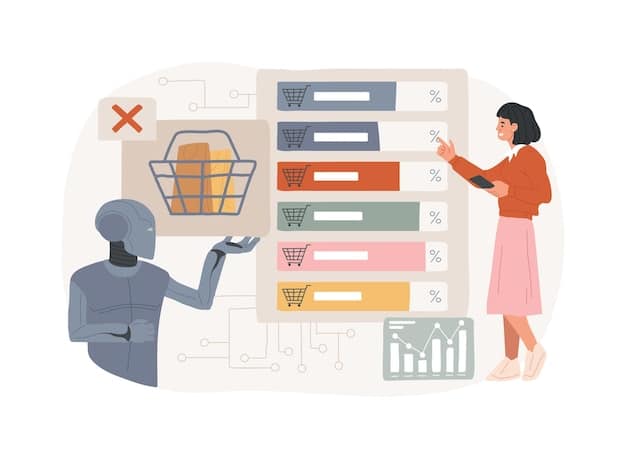Chargeback Prevention Strategies: Proven Methods to Reduce Disputes in US E-commerce

Chargeback Prevention Strategies: Reduce Disputes by 20% with These Proven Methods for US E-commerce involves implementing proactive measures like clear communication, secure payment gateways, and robust fraud detection to minimize costly chargebacks and protect revenue.
Chargebacks can be a significant drain on resources and profitability for e-commerce businesses in the US. Implementing effective Chargeback Prevention Strategies: Reduce Disputes by 20% with These Proven Methods for US E-commerce is crucial for protecting your revenue and maintaining a healthy business.
This article will explore practical and proven chargeback prevention strategies that US e-commerce businesses can implement today. We’ll guide you through methods to significantly reduce disputes and safeguard your bottom line. Are you ready to learn the most effective techniques forchargeback prevention?
Understanding the Chargeback Landscape in US E-commerce
Before diving into the solutions, it’s important to understand what chargebacks are and how they affect the US e-commerce landscape. Chargeback Prevention Strategies: Reduce Disputes by 20% with These Proven Methods for US E-commerce starts with understanding the enemy and its tactics.
What is a Chargeback?
A chargeback occurs when a customer disputes a transaction with their credit card issuer. The issuer then reverses the transaction and debits the merchant’s account. This is often due to fraud, dissatisfaction with the product or service, or billing errors.
The Impact of Chargebacks on US E-commerce
Chargebacks can significantly impact e-commerce businesses, leading to:
- Lost revenue from the reversed transaction.
- Chargeback fees assessed by the payment processor.
- Increased operational costs for investigating and resolving disputes.
- Damage to the merchant’s reputation and standing with payment processors.
Effective Chargeback Prevention Strategies: Reduce Disputes by 20% with These Proven Methods for US E-commerce are vital for minimizing these impacts.
Understanding the landscape, now let’s explore key prevention tactics to protect your business.

Implementing Robust Fraud Detection Systems
One of the primary reasons for chargebacks is fraudulent transactions. Implementing robust fraud detection systems is a keystone of any effective Chargeback Prevention Strategies: Reduce Disputes by 20% with These Proven Methods for US E-commerce.
Address Verification System (AVS)
AVS compares the billing address provided by the customer with the address on file with the card issuer. A mismatch can be an indicator of fraud.
Card Verification Value (CVV)
CVV requires customers to enter the three- or four-digit security code on the back of their credit card. This helps ensure that the customer has physical possession of the card.
IP Address Geolocation
By tracking the IP address of the customer, you can identify transactions originating from high-risk locations or those that don’t match the customer’s stated location.
Machine Learning and AI
Modern fraud detection systems leverage machine learning and artificial intelligence to analyze transaction patterns and identify suspicious activities in real-time. These systems can adapt to evolving fraud tactics and provide a more comprehensive layer of protection.
Leveraging multiple fraud detection tools offers a multilayered defense to proactively catch fraudulent transactions that may later result in chargebacks.
Optimizing the Customer Experience to Reduce Disputes
Customer disputes often arise from misunderstandings or dissatisfaction with the purchase process. Chargeback Prevention Strategies: Reduce Disputes by 20% with These Proven Methods for US E-commerce also involves optimizing the customer experience ensures customer satisfaction and reduces the likelihood of disputes.
Clear and Accurate Product Descriptions
Provide detailed and accurate product descriptions, including high-quality images and videos. This helps customers make informed decisions and reduces the chance of dissatisfaction upon receiving the product.
Easy-to-Find Contact Information
Make it easy for customers to contact you with questions or concerns. Prominently display your phone number, email address, and live chat options on your website.
Expedient Customer Service
Train your customer service team to efficiently and effectively resolve customer issues. Prompt and helpful service can turn a potential dispute into a satisfied customer.
Transparent Return and Refund Policies
Clearly communicate your return and refund policies on your website and in order confirmations. A hassle-free return process can prevent customers from resorting to chargebacks.
An emphasis on customer experience reduces potential issues from occurring that may lead to chargebacks in the first place.

Enhancing Communication and Transparency
Open communication is essential for preventing chargebacks rooted in misunderstandings or unclear expectations. Effective Chargeback Prevention Strategies: Reduce Disputes by 20% with These Proven Methods for US E-commerce involves enhancing communication and transparency at every touchpoint.
Order Confirmations and Shipping Updates
Send detailed order confirmations with a summary of the purchase, billing information, and shipping details. Provide regular shipping updates with tracking information to keep customers informed about the status of their order.
Proactive Notifications about Potential Delays
If there are any delays in shipping or order processing, notify customers immediately and provide an explanation. This proactive approach can prevent frustration and potential disputes.
Clear Billing Descriptors
Use clear and recognizable billing descriptors on customers’ credit card statements. This helps them easily identify the transaction and avoid confusion or suspicion of fraud. Use your registered business name.
Follow-up Emails After Delivery
Send follow-up emails after delivery to ensure customer satisfaction and address any concerns proactively. This also provides an opportunity for customers to leave reviews or provide feedback.
Creating communication channels ensures customers are always kept in the loop and may prevent them from jumping straight to a chargeback.
Securing Payment Gateways and Data Transmission
Data breaches can lead to fraudulent transactions and subsequent chargebacks. Ensuring secure payment gateways and data transmission is an important part of Chargeback Prevention Strategies: Reduce Disputes by 20% with These Proven Methods for US E-commerce.
PCI DSS Compliance
Comply with the Payment Card Industry Data Security Standard (PCI DSS) to ensure that your payment processing systems meet the highest security standards. PCI DSS compliance helps protect sensitive cardholder data and reduces the risk of data breaches.
SSL Encryption
Use Secure Sockets Layer (SSL) encryption to protect data transmitted between the customer’s browser and your server. SSL encryption ensures that sensitive information such as credit card numbers and personal details are secure during transmission.
Tokenization
Tokenization replaces sensitive cardholder data with a unique token that can be used to process transactions without exposing the actual card number. This minimizes the risk of data breaches and reduces the scope of PCI DSS compliance.
Regular Security Audits
Conduct regular security audits of your payment processing systems to identify and address potential vulnerabilities. Security audits help ensure that your systems are up-to-date and protected against emerging threats.
Securing your payment gateways protects customer data and keeps fraudulent users from conducting transactions that may lead to chargebacks.
Monitoring and Analyzing Chargeback Data
Monitoring and analyzing chargeback data can provide valuable insights into the root causes of disputes and identify areas for improvement. Effective Chargeback Prevention Strategies: Reduce Disputes by 20% with These Proven Methods for US E-commerce relies on continuous monitoring and analysis.
Track Chargeback Ratios
Monitor your chargeback ratios on a regular basis to identify any spikes or trends. A high chargeback ratio can trigger penalties from payment processors and may lead to account termination.
Categorize Chargeback Reasons
Categorize chargebacks by reason code to identify the most common causes of disputes. This helps you understand the specific areas that need improvement, such as fraud prevention, customer service, or product quality.
Identify High-Risk Products or Customers
Analyze chargeback data to identify products or customer segments that are associated with a higher risk of disputes. This allows you to implement targeted prevention measures, such as enhanced fraud screening or improved product descriptions.
Use Data to Refine Prevention Strategies
Use the insights gained from chargeback data to continuously refine and improve your prevention strategies. This data-driven approach ensures that your chargeback prevention efforts are effective and aligned with your business needs.
Analyzing chargeback data allows one to adapt their prevention measures and be better positioned to protect their business.
| Key Aspect | Brief Description |
|---|---|
| 🛡️ Fraud Detection | Implement AVS, CVV, IP geolocation, & AI to prevent fraudulent transactions. |
| 📞 Customer Service | Offer instant support and manage issues before disputes arise. |
| 🔒 Secure Payments | Use PCI DSS, SSL, & tokenization; secure payment gateways minimize breaches. |
| 📊 Data Analysis | Track rates & dispute reasons to optimize your current Chargeback Prevention Strategies: Reduce Disputes by 20% with These Proven Methods for US E-commerce. |
FAQ
Key strategies include robust fraud detection, optimized customer experience, transparent communication, secure payment gateways, and continuous monitoring of chargeback data.
Fraud detection systems like AVS, CVV, and AI identify and block fraudulent transactions, which prevents chargebacks resulting from unauthorized purchases.
Clear and timely communication, including order confirmations, shipping updates, and proactive notifications, helps manage customer expectations and prevent disputes caused by misunderstandings.
Secure payment gateways with PCI DSS compliance, SSL encryption, and tokenization protect sensitive cardholder data, reducing the risk of data breaches and fraudulent transactions.
Monitoring and categorizing chargeback reasons helps identify trends and areas for improvement, allowing businesses to refine their prevention strategies and reduce future disputes.
Conclusion
Implementing effective Chargeback Prevention Strategies: Reduce Disputes by 20% with These Proven Methods for US E-commerce is essential for US e-commerce businesses aiming to protect their revenue and reputation. By focusing on fraud detection, customer experience, and data security, merchants can significantly reduce the number of costly chargebacks.
By understanding the chargeback landscape, implementing proactive measures, and continuously refining prevention strategies, you will establish a shield to protect your business. The steps discussed provide a solid foundation to prevent fraud, improve experiences, and secure payments, all of which lead to a healthier bottom line.





